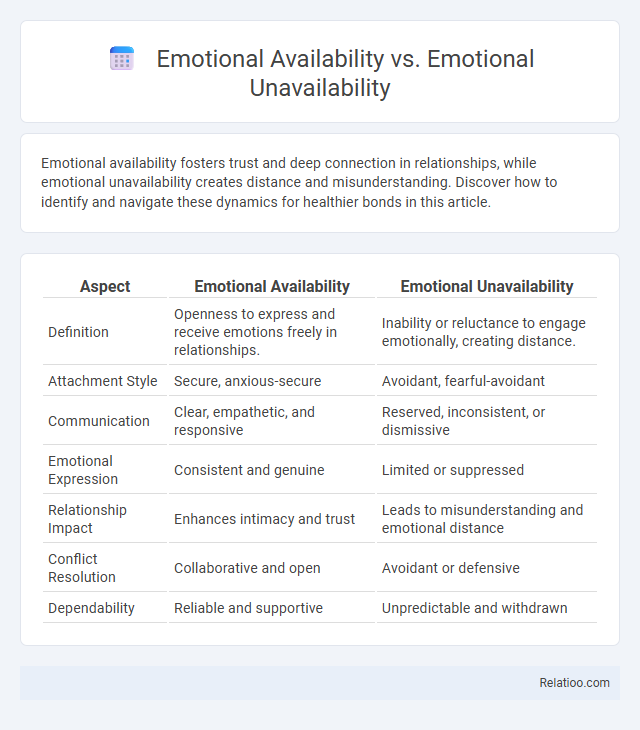Emotional availability fosters trust and deep connection in relationships, while emotional unavailability creates distance and misunderstanding. Discover how to identify and navigate these dynamics for healthier bonds in this article.
Table of Comparison
| Aspect | Emotional Availability | Emotional Unavailability |
|---|---|---|
| Definition | Openness to express and receive emotions freely in relationships. | Inability or reluctance to engage emotionally, creating distance. |
| Attachment Style | Secure, anxious-secure | Avoidant, fearful-avoidant |
| Communication | Clear, empathetic, and responsive | Reserved, inconsistent, or dismissive |
| Emotional Expression | Consistent and genuine | Limited or suppressed |
| Relationship Impact | Enhances intimacy and trust | Leads to misunderstanding and emotional distance |
| Conflict Resolution | Collaborative and open | Avoidant or defensive |
| Dependability | Reliable and supportive | Unpredictable and withdrawn |
Understanding Emotional Availability
Emotional availability refers to your openness and responsiveness to both your own emotions and those of others, fostering genuine connection and trust in relationships. In contrast, emotional unavailability occurs when individuals are detached or unwilling to engage emotionally, often leading to misunderstandings and distance. Emotional withholding involves consciously suppressing feelings, which can create barriers to intimacy and prevent authentic communication.
Signs of Emotional Availability
Signs of emotional availability include open communication, empathy, and responsiveness to a partner's feelings, promoting trust and intimacy in relationships. Individuals who are emotionally available express vulnerability and actively listen, creating a safe space for emotional connection. In contrast, emotional unavailability and withholding manifest as avoidance, detachment, and reluctance to share emotions, hindering genuine relational bonding.
What is Emotional Unavailability?
Emotional unavailability refers to a person's difficulty or refusal to connect deeply on an emotional level, often leading to distance or detachment in relationships. Unlike emotional withholding, which involves consciously holding back feelings, emotional unavailability is typically an unconscious protective mechanism caused by past trauma, fear of vulnerability, or unresolved personal issues. Recognizing emotional unavailability in Your relationships allows You to address underlying barriers and cultivate healthier emotional connections.
Common Traits of Emotionally Unavailable Individuals
Emotionally unavailable individuals often struggle with expressing vulnerability, maintaining deep connections, and managing their emotions effectively, resulting in inconsistent communication and avoidance of intimate conversations. These individuals may exhibit patterns of detachment, lack empathy, and frequently withdraw from emotional situations, creating barriers to building trust and emotional safety. Understanding these common traits can help you recognize and navigate relationships where emotional withholding or unavailability impacts intimacy and connection.
Causes Behind Emotional Unavailability
Emotional unavailability often stems from deep-rooted causes such as past trauma, fear of vulnerability, or attachment issues formed in early relationships. Unlike emotional withholding, where feelings are consciously concealed, emotional unavailability can be an unconscious defense mechanism, preventing genuine connection. Understanding these causes helps you recognize patterns and fosters healthier emotional engagement.
Emotional Availability in Relationships
Emotional availability in relationships refers to the ability to openly express and respond to emotions, fostering trust, empathy, and intimacy between partners. It involves being present, vulnerable, and attuned to each other's emotional needs, which strengthens connection and promotes healthy communication. In contrast, emotional unavailability and emotional withholding create barriers to intimacy, often leading to misunderstandings, frustration, and relational disconnection.
Impact of Emotional Unavailability on Partnerships
Emotional unavailability in partnerships often leads to communication breakdowns, decreased intimacy, and increased feelings of loneliness for both partners. Your ability to connect deeply is hindered when one partner consistently withholds emotions, creating distance and mistrust that undermines relationship stability. Recognizing and addressing emotional withholding is essential to foster vulnerability and strengthen emotional bonds within your partnership.
Overcoming Emotional Unavailability
Emotional unavailability occurs when individuals struggle to connect or respond to others' feelings, often leading to relationship challenges, whereas emotional withholding involves consciously suppressing emotions despite being able to feel them. Overcoming emotional unavailability requires increasing self-awareness, developing emotional literacy, and practicing vulnerability in safe environments to foster genuine connections. Techniques such as therapy, mindfulness, and consistent communication enhance emotional availability by reducing fear of intimacy and promoting open expression of feelings.
Building Emotional Intimacy
Building emotional intimacy relies heavily on understanding the differences between emotional availability, unavailability, and withholding. Emotional availability means you are open, responsive, and attuned to your partner's feelings, fostering trust and deep connection. In contrast, emotional unavailability and withholding create barriers that hinder vulnerability and weaken the foundation of intimacy in your relationship.
Choosing Emotional Wellness in Relationships
Emotional availability in relationships fosters open communication, empathy, and trust, essential for emotional wellness and deeper connections. Emotional unavailability often stems from past trauma or fear of intimacy, leading to detachment and misunderstandings between partners. Choosing emotional wellness means recognizing these patterns, promoting vulnerability, and creating a safe space for mutual support and growth.

Infographic: Emotional Availability vs Emotional Unavailability
 relatioo.com
relatioo.com